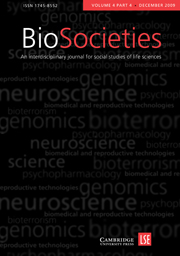Crossref Citations
This article has been cited by the following publications. This list is generated based on data provided by
Crossref.
Keller, Evelyn Fox
2009.
Knowing As Making, Making As Knowing: The Many Lives of Synthetic Biology.
Biological Theory,
Vol. 4,
Issue. 4,
p.
333.
Kelty, Christopher M
2012.
This is not an article: Model organism newsletters and the question of ‘open science’.
BioSocieties,
Vol. 7,
Issue. 2,
p.
140.
Delgado, Ana
Funtowicz, Silvio
and
Dankel, Dorothy
2012.
Super-Computers, Evolution and the Fabrication of Life.
International Journal of Social Ecology and Sustainable Development,
Vol. 3,
Issue. 2,
p.
11.
Calvert, Jane
2012.
Systems biology, synthetic biology and data-driven research: A commentary on Krohs, Callebaut, and O’Malley and Soyer.
Studies in History and Philosophy of Science Part C: Studies in History and Philosophy of Biological and Biomedical Sciences,
Vol. 43,
Issue. 1,
p.
81.
Holm, Sune
2012.
The Scientific Aspirations of Synthetic Biology and the Need for Analytic Ethics.
Ethics, Policy & Environment,
Vol. 15,
Issue. 1,
p.
25.
Porcar, Manuel
and
Peretó, Juli
2012.
Are we doing synthetic biology?.
Systems and Synthetic Biology,
Vol. 6,
Issue. 3-4,
p.
79.
Zurr, Ionat
2012.
Of instrumentalisation of life and the vitality of matter.
Dialogues in Human Geography,
Vol. 2,
Issue. 3,
p.
288.
Kearnes, M.
2013.
Performing synthetic worlds: Situating the bioeconomy.
Science and Public Policy,
Vol. 40,
Issue. 4,
p.
453.
Delgado, Ana
and
Porcar, Manuel
2013.
Designing de novo: interdisciplinary debates in synthetic biology.
Systems and Synthetic Biology,
Vol. 7,
Issue. 1-2,
p.
41.
Roosth, Sophia
2013.
Biobricks and Crocheted Coral: Dispatches from the Life Sciences in the Age of Fabrication.
Science in Context,
Vol. 26,
Issue. 1,
p.
153.
Bensaude Vincent, Bernadette
2013.
Discipline-building in synthetic biology.
Studies in History and Philosophy of Science Part C: Studies in History and Philosophy of Biological and Biomedical Sciences,
Vol. 44,
Issue. 2,
p.
122.
Mackenzie, Adrian
2013.
Realizing the promise of biotechnology: Infrastructural-icons in synthetic biology.
Futures,
Vol. 48,
Issue. ,
p.
5.
Mackenzie, Adrian
2013.
Synthetic biology and the technicity of biofuels.
Studies in History and Philosophy of Science Part C: Studies in History and Philosophy of Biological and Biomedical Sciences,
Vol. 44,
Issue. 2,
p.
190.
Finlay, Susanna Claire
2013.
Engineering biology? Exploring rhetoric, practice, constraints and collaborations within a synthetic biology research centre.
Engineering Studies,
Vol. 5,
Issue. 1,
p.
26.
Kastenhofer, Karen
2013.
Synthetic biology as understanding, control, construction, and creation? Techno-epistemic and socio-political implications of different stances in talking and doing technoscience.
Futures,
Vol. 48,
Issue. ,
p.
13.
Calvert, Jane
2013.
Engineering Biology and Society: Reflections on Synthetic Biology.
Science, Technology and Society,
Vol. 18,
Issue. 3,
p.
405.
Rossi, Jairus
2013.
The Socionatural Engineering of Reductionist Metaphors: A Political Ecology of Synthetic Biology.
Environment and Planning A: Economy and Space,
Vol. 45,
Issue. 5,
p.
1127.
Delgado, Ana
Funtowicz, Silvio
Dankel, Dorothy
and
Strand, Roger
2013.
Plug and play: Synthetic biology and the dream of engineering life.
Futures,
Vol. 48,
Issue. ,
p.
1.
Ruiz-Mirazo, Kepa
and
Moreno, Alvaro
2013.
Synthetic Biology: Challenging Life in Order to Grasp, Use, or Extend It.
Biological Theory,
Vol. 8,
Issue. 4,
p.
376.
Porcar, Manuel
and
Peretó, Juli
2014.
Synthetic Biology.
Vol. 12,
Issue. ,
p.
63.


